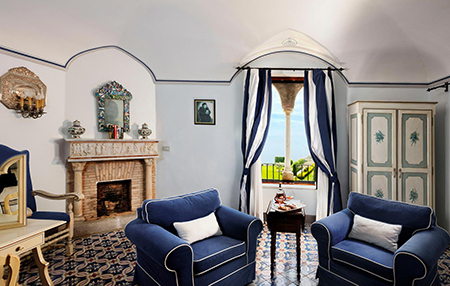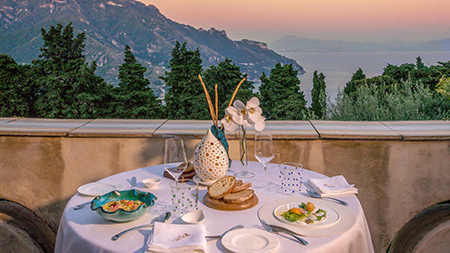History
Villa Cimbrone, a particularly symbolic site on the Amalfi coast at Ravello, is immersed in a luxuriant garden with a breathtaking view. First reports of the house date back to the 11th century when it belonged to the noble Acconciajoco family, then in 1273 it was acquired by the Fusco family, aristocrats from Ravello, related to the Pitti family from Florence and the D'Angị from Naples, who owned it for more than five centuries. The Fusco family were responsible for the main improvements on the house and garden which were previously exclusively agricultural. The Belvedere Terrace, the long access avenue with a domed pavilion, the distribution of marble busts and numerous terracotta pieces, all date to the close of the Renaissance. Also the main building, created as a ‘palatial abode' for entertainment, was modified with the addition of vaulted living rooms decorated with bizzarre figures and floral motifs
The difficult political-economic situation between the eighteenth and nineteenth centuries and the diffusion of ‘banditry' in the area, especially around 1860, induced the Fusco family to abandon Villa Cimbrone. After a short spell in which it belonged to the Amici from Atrani, a family of tradesmen, it was bought in 1904 by Ernest William Beckett, Lord Grimthorpe, a wealthy British man, who restored the building, introducing Arabic, Venetian and Gothic touches in tune with contemporary multi-faceted taste.
The terraced gardens cover roughly eight and a half hectares of the southernmost tip of the Ravello hillside, one of the most panoramic spots for admiring the marvellous Amalfi Coastline.
The Villa became a cultural circle and meeting point for European intellectuals and the Italian home for the Bloomsbury Group between 1910 and 1930. It is plausible that Vita Sackville West contributed to the new vision for the garden at this time. She frequently stayed with the Beckett family and had strong ties with Violet Trefusis, the illegitimate daughter of Lord Grimthorpe, and Alice Keppel, also with Virginia Woolf.
Magnificent trees are interspersed with fountains, avenues, sculptures and little temples following the dictates of Anglo Saxon 19th century romantic and landscape culture. The botanical collection includes huge trees, pergolas of wisteria sinensis, an incredible variety of irises, copses of ancient strawberry trees, borders of hydrangeas and other perennials, topiary and a recently restored rose garden with more than sixty varieties of old roses - English, French and modern.
During the Fascist period it was confiscated as British property until the end of the Second World War, so was neglected once again. Nevertheless, after the ‘60s it reacquired its old dignity as both historic site and botanical garden in the hands of the Vuilleumier family, totally dedicated for three generations now. The house has become an extraordinarily fascinating hotel with frescoed ceilings, works of art and antiquities imbued with an atmosphere from the early 1900s.










